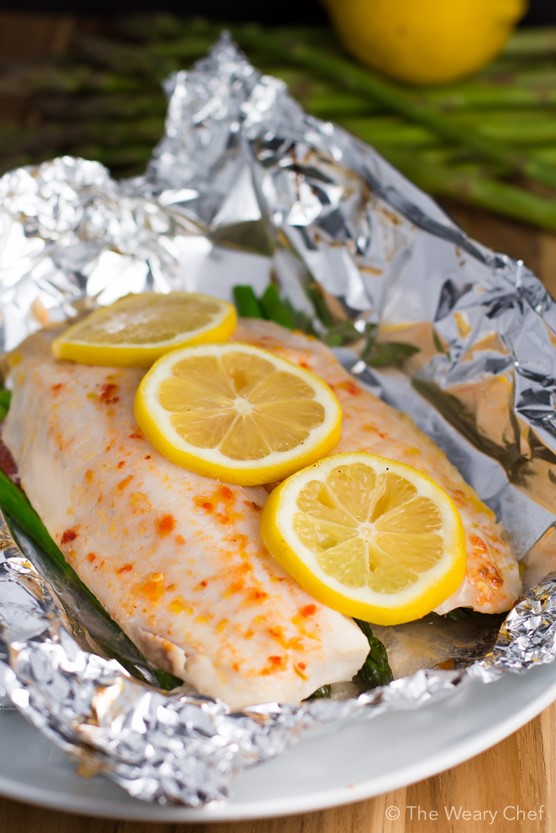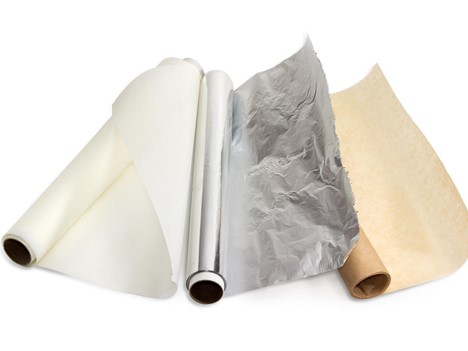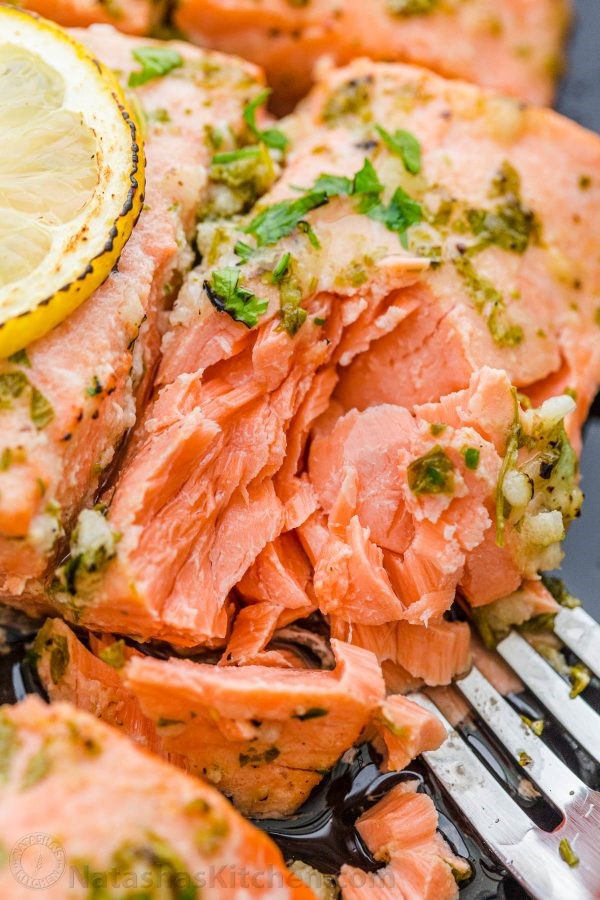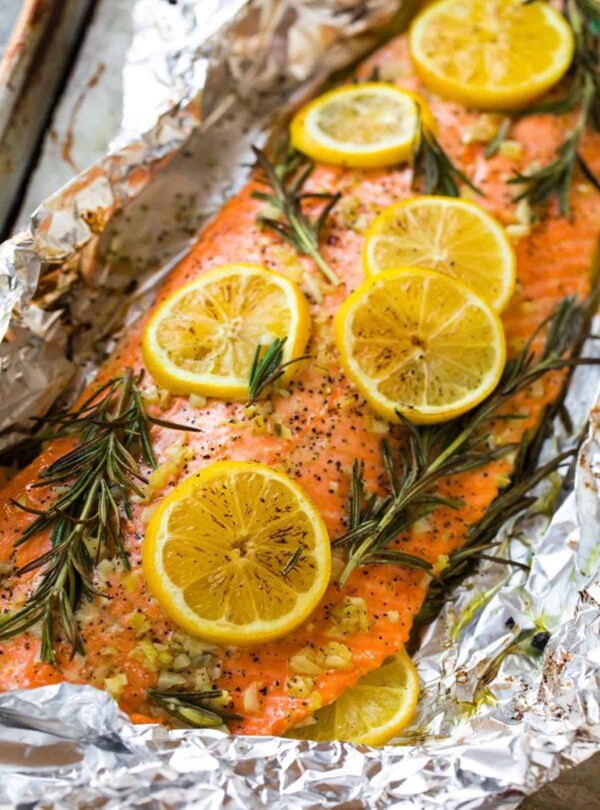Successfully Cooking Salmon is Not Rocket Science!
What’s your comfort level around cooking fish? I’ve been a little intimidated by it in the past—especially salmon. I was convinced it was too complicated for a nonprofessional to mess with. I was scared I’d botch an expensive and beautiful piece of fish.
All of that changed after I discovered a salmon-cooking tutorial on Erin Clarke’s terrific site, Well Plated. She’s a big advocate of using foil for baking fish, especially salmon.

So why bake salmon in foil? Two important reasons:
But if you prefer not to use foil out of health concerns, then incorporate parchment paper. Baking salmon in foil calls for misting the foil with nonstick spray. So simply line the foil sheet with a piece of parchment paper. Just be sure to lay the salmon on the parchment so that it doesn’t touch the foil. Shape the foil packet around the parchment and bake as directed.

It's worth the time and effort to master the art of salmon-cooking. It’s not just delicious, it’s so good for you. It’s rich in omega-3 fatty acids (which can help reduce inflammation, lower blood pressure, and decrease risk factors for diseases). It’s a great source of protein, potassium, and selenium (a mineral that protects bone health, improves thyroid function, and reduces the risk of cancer). Salmon also helps reduce the risk of heart disease, aids in weight control, and protects brain health.
One common mistake in cooking or baking salmon is giving it too much time with the heat. It’s easy to overdo it and end up with a dry, tasteless result. In general, a large (2-pound) side of salmon bakes at 375 degrees F in only15 to 20 minutes. You want to remember that cooking time can be several minutes longer or shorter depending upon the thickness of your particular piece of salmon.
You also want to know how to determine the best baking temperature. Generally, when making individual pieces (about 6-ounce fillets), bake at 400°F or 425°F. Smaller portions cook quickly and can stand a higher temperature. However, 400°+ would be too aggressive for a large side of salmon. Cooking large pieces at 350°F takes longer and the result isn’t as moist or flavorful as it could be. Professional chefs agree, the best approach with large sides of salmon is to bake at 375°F.

So the bottom line, and basic rule of thumb: DON’T overbake. The baking time always varies based upon the size and thickness of your salmon. Wild-caught salmon (typically sockeye or coho) for instance, is thinner and thus cooks more quickly. And farm-raised salmon (which is often Atlantic), will likely be thicker and need more time.
Here are a few professional tips on how to turn out the best tasting salmon:

There are lots of tasty ways to cook salmon in foil. While all you really need for a satisfying piece of baked salmon is salt, pepper, and olive oil, the foil method easily adapts to a variety of herbs and ingredients. For instance:
Baked Salmon with Lemon and Pesto.
Baked Salmon in Foil with Lemon and Dill.
Baked Salmon with Lemon and Butter.
Garlic Butter Salmon
Soy Sauce and Ginger Salmon.
Balsamic Salmon.
Baked Salmon with Lemon and Rosemary. This is the version I prepared last night (to rave revues) and I’ll close with this delicious recipe and my encouragement to give salmon a try, if you haven’t already. Contrary to what I’d thought for so many years, there’s nothing to be afraid of; it’s not rocket science!

1 2 pound side salmon - boneless (skin on or off, depending upon your preference), wild caught if possible
5 sprigs fresh rosemary (or fresh herbs of your choice; do not use dried herbs)
2 small lemons (divided, plus extra for serving as desired)
2 tablespoons extra virgin olive oil
1 teaspoon kosher salt
1/4 teaspoon freshly ground black pepper
4 cloves garlic (peeled and roughly chopped)
Additional chopped fresh herbs, such as basil, thyme, parsley, dill, or green onion (optional)
Directions:
Add Recipe to Cook'n
blog comments powered by Disqus
All of that changed after I discovered a salmon-cooking tutorial on Erin Clarke’s terrific site, Well Plated. She’s a big advocate of using foil for baking fish, especially salmon.

So why bake salmon in foil? Two important reasons:
- The foil locks in moisture and ensures that your beautiful piece of salmon turns out flakey, moist, and tender every single time. You don’t need to have ever cooked a piece of fish in your life to make this recipe with success.
- Foil acts as a flavor incubator. Whatever yummy ingredients you place with the fish in the foil infuse their way into every savory bite.
But if you prefer not to use foil out of health concerns, then incorporate parchment paper. Baking salmon in foil calls for misting the foil with nonstick spray. So simply line the foil sheet with a piece of parchment paper. Just be sure to lay the salmon on the parchment so that it doesn’t touch the foil. Shape the foil packet around the parchment and bake as directed.

It's worth the time and effort to master the art of salmon-cooking. It’s not just delicious, it’s so good for you. It’s rich in omega-3 fatty acids (which can help reduce inflammation, lower blood pressure, and decrease risk factors for diseases). It’s a great source of protein, potassium, and selenium (a mineral that protects bone health, improves thyroid function, and reduces the risk of cancer). Salmon also helps reduce the risk of heart disease, aids in weight control, and protects brain health.
One common mistake in cooking or baking salmon is giving it too much time with the heat. It’s easy to overdo it and end up with a dry, tasteless result. In general, a large (2-pound) side of salmon bakes at 375 degrees F in only15 to 20 minutes. You want to remember that cooking time can be several minutes longer or shorter depending upon the thickness of your particular piece of salmon.
You also want to know how to determine the best baking temperature. Generally, when making individual pieces (about 6-ounce fillets), bake at 400°F or 425°F. Smaller portions cook quickly and can stand a higher temperature. However, 400°+ would be too aggressive for a large side of salmon. Cooking large pieces at 350°F takes longer and the result isn’t as moist or flavorful as it could be. Professional chefs agree, the best approach with large sides of salmon is to bake at 375°F.

So the bottom line, and basic rule of thumb: DON’T overbake. The baking time always varies based upon the size and thickness of your salmon. Wild-caught salmon (typically sockeye or coho) for instance, is thinner and thus cooks more quickly. And farm-raised salmon (which is often Atlantic), will likely be thicker and need more time.
Here are a few professional tips on how to turn out the best tasting salmon:
- Foil baking is the way to go as it locks in moisture, but you want to pull it out when it is almost but not quite done at the thickest part.
- A quick broil will give a nice finish to fish top and cook it through the rest of the way.
- If you’re worried about overcooking, remove it from the oven, and keeping it covered, let it rest at room temperature for several minutes (it’ll continue cooking).
- Test for doneness by taking a sharp knife and peeking into the thickest part of your baked piece. If it’s beginning to flake, but still has a little translucency in the middle, it is done; or once your salmon flakes easily with a fork, it’s done.

There are lots of tasty ways to cook salmon in foil. While all you really need for a satisfying piece of baked salmon is salt, pepper, and olive oil, the foil method easily adapts to a variety of herbs and ingredients. For instance:
Baked Salmon with Lemon and Pesto.
Baked Salmon in Foil with Lemon and Dill.
Baked Salmon with Lemon and Butter.
Garlic Butter Salmon
Soy Sauce and Ginger Salmon.
Balsamic Salmon.
Baked Salmon with Lemon and Rosemary. This is the version I prepared last night (to rave revues) and I’ll close with this delicious recipe and my encouragement to give salmon a try, if you haven’t already. Contrary to what I’d thought for so many years, there’s nothing to be afraid of; it’s not rocket science!

Baked Salmon with Lemon and Rosemary
Ingredients:
1 2 pound side salmon - boneless (skin on or off, depending upon your preference), wild caught if possible
5 sprigs fresh rosemary (or fresh herbs of your choice; do not use dried herbs)
2 small lemons (divided, plus extra for serving as desired)
2 tablespoons extra virgin olive oil
1 teaspoon kosher salt
1/4 teaspoon freshly ground black pepper
4 cloves garlic (peeled and roughly chopped)
Additional chopped fresh herbs, such as basil, thyme, parsley, dill, or green onion (optional)
Directions:
1. Remove the salmon from the refrigerator and let stand at room temperature for 10 minutes while you prepare the other ingredients. Heat oven to 375 degrees F. Line a large baking dish or rimmed baking sheet with a large piece of aluminum foil.
2. Lightly coat the foil with baking spay, then arrange 2 sprigs of the rosemary down the middle. Cut one of the lemons into thin slices and arrange half the slices down the middle with the rosemary. Place the salmon on top.
3. Drizzle the salmon with the olive oil and sprinkle with the salt and pepper. Rub to coat, then scatter the garlic cloves over the top. Lay the remaining rosemary and lemon slices on top of the salmon. Juice the second lemon, then pour the juice over the top.
4. Fold the sides of the aluminum foil up and over the top of the salmon until it is completely enclosed. If your piece of foil is not large enough, place a second piece on top and fold the edges under so that it forms a sealed packet. Leave a little room inside the foil for air to circulate.
5. Bake the salmon for 15-20 minutes, until the salmon is almost completely cooked through at the thickest part. The cooking time will vary based on the thickness of your salmon. If your side is thinner (around 1-inch thick) check several minutes early to ensure your salmon does not overcook. If your piece is very thick (1 1/2 inches or more), it may need longer.
6. Remove the salmon from the oven and carefully open the foil so that the top of the fish is completely uncovered (be careful of hot steam). Change the oven setting to broil, then return the fish to the oven and broil for 3 minutes, until the top of the salmon and the garlic are slightly golden and the fish is cooked through. Watch the salmon closely as it broils to make sure it doesn’t overcook and the garlic does not burn. Remove the salmon from the oven. If it still appears a bit underdone, you can wrap the foil back over the top and let it rest for a few minutes.
7. Do not let it sit too long—salmon can progress from "not done" to "over done" very quickly. As soon as it flakes easily with a fork, it's ready.
8. To serve, cut the salmon into portions. Sprinkle with additional fresh herbs or top with an extra squeeze of lemon as desired.
Notes: This recipe is best enjoyed the day that it is made, as salmon can dry out when reheated. That said, there are still many yummy ways to use leftover salmon! Try serving it room temperature over a salad the next day, mixing it with pasta, or flaking and scrambling it with eggs.
2. Lightly coat the foil with baking spay, then arrange 2 sprigs of the rosemary down the middle. Cut one of the lemons into thin slices and arrange half the slices down the middle with the rosemary. Place the salmon on top.
3. Drizzle the salmon with the olive oil and sprinkle with the salt and pepper. Rub to coat, then scatter the garlic cloves over the top. Lay the remaining rosemary and lemon slices on top of the salmon. Juice the second lemon, then pour the juice over the top.
4. Fold the sides of the aluminum foil up and over the top of the salmon until it is completely enclosed. If your piece of foil is not large enough, place a second piece on top and fold the edges under so that it forms a sealed packet. Leave a little room inside the foil for air to circulate.
5. Bake the salmon for 15-20 minutes, until the salmon is almost completely cooked through at the thickest part. The cooking time will vary based on the thickness of your salmon. If your side is thinner (around 1-inch thick) check several minutes early to ensure your salmon does not overcook. If your piece is very thick (1 1/2 inches or more), it may need longer.
6. Remove the salmon from the oven and carefully open the foil so that the top of the fish is completely uncovered (be careful of hot steam). Change the oven setting to broil, then return the fish to the oven and broil for 3 minutes, until the top of the salmon and the garlic are slightly golden and the fish is cooked through. Watch the salmon closely as it broils to make sure it doesn’t overcook and the garlic does not burn. Remove the salmon from the oven. If it still appears a bit underdone, you can wrap the foil back over the top and let it rest for a few minutes.
7. Do not let it sit too long—salmon can progress from "not done" to "over done" very quickly. As soon as it flakes easily with a fork, it's ready.
8. To serve, cut the salmon into portions. Sprinkle with additional fresh herbs or top with an extra squeeze of lemon as desired.
Notes: This recipe is best enjoyed the day that it is made, as salmon can dry out when reheated. That said, there are still many yummy ways to use leftover salmon! Try serving it room temperature over a salad the next day, mixing it with pasta, or flaking and scrambling it with eggs.
Recipe formatted with the Cook'n Recipe Software from DVO Enterprises.
Sources:
- www.thewearychef.com
- www.myrecipes.com
- www.natashaskitchen.com
- www.littlebroken.com
- www.wellplated.com
 Alice Osborne
Alice Osborne
Weekly Newsletter Contributor since 2006
Email the author! alice@dvo.com
